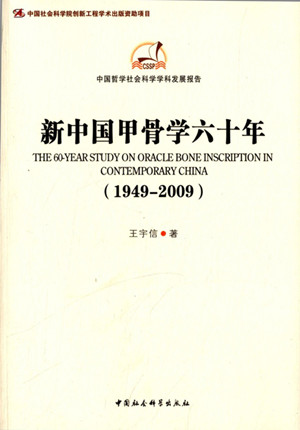60-Year Study on Oracle Bone Inscription in Contemporary China
Author : Wang Yuxin Source : Chinese Social Sciences Today 2014-11-27

The 60-Year Study on Oracle Bone Inscription in Contemporary China
Author: Wang Yuxin
Publisher: China Social Sciences Press
Oracle bone studies:an evolving discipline
By Chao Fulin and Wang Kunpeng
Since 1899, when antiquarian and philologist Wang Yirong (1845-1900) first recognized the significance of fragments of bone and shells engraved with ancient script, a series of scholars have followed in his footsteps, yielding a wealth o f new findings that shed light on previously unknown aspects of ancient Chinese history. These researchers include Liu Er (1857–1909), the author of the first book of oracle bone inscription rubbings; Sun Yirang (1848–1908), the first serious researcher in the field; Luo Zhenyu (1866–1940), who identified the names of the Shang kings, and Wang Guowei (1877–1927), who demonstrated that the chronology of the Shang kings matched that in Sima Qian’s Records of the Grand Historian.
Jiaguxue, meaning “oracle bone studies,” has also become a noted field of study that has inspired interest in generations of scholars from 1899 to the present.
Wang Yuxin’s 60-Year Study on Oracle Bone Inscription in Contemporary China offers an in-depth analysis of oracle bone studies in different times.
Looking back, Chinese scholar Chen Mengjia discussed some major issues in oracle bone studies and the history of Yin in his work A Comprehensive Study of the Divination Inscriptions from the Ruins of Yin, but he did not put much emphasis on the disciplinary development of oracle bone studies. Dong Zuobin (1895–1963) established a chronology of oracle bones studies before the 1960s in his work The 60-Year Study on Oracle Bone Inscription while Hu Houxuan (1911-1995) summarized the evacuation and circulation of oracle bones before the founding of the People’s Republic of China in 1949.
Wang’s The 60-Year Study on Oracle Bone Inscription in Contemporary China has picked up the torch and enriched the study of oracle bones by writing on newly discovered relics and expanding oracle bone research while exploring its relation to other disciplines.
The book emphasizes the impacts of academic environment and methodology on oracle bone research. In the late Qing and early Republican period, China underwent tremendous changes as traditional culture entered into a phase of self-criticism and self-improvement. During this time, scholars harshly criticized traditional ancient history and discarded a number of documents because of doubts about authenticity.
In this context, scholars like Wang Guowei (1877-1927) turned to oracle bone materials, setting a precedent for later research. For similar reasons, bones and shells were archaeologically excavated during the time between 1928-1937 in the Yin Ruins of Anyang, Henan, by the Academia Sinica’s Institute of History and Philology. Altogether more than 20,000 pieces of shell and bone were obtained.
In addition, Wang’s the 60-Year Study explores the fundamental impact the historical materialism of Marx and Engels had on oracle bone research, with a focus on the dating criteria great writer Guo Moruo (1892–1978) developed.
The book also details how the advancement of archaeology and related disciplines helped promote the study of oracle bones. One example is how the dating criteria for the Shang dynasty, which ruled central China between the 16th and 11th centuries B.C., has been altered based on the archaeological excavations after the founding of the People’s Republic of China.
Chao Fulin and Wang Kunpeng are from the Beijing Normal University.
Translated by Yang Xue
Ye Shengtao made Chinese fairy tales from a wilderness
Ye Shengtao (1894–1988) created the first collection of fairy tales in the history of Chinese children’s literature...
-
How northern ethnicities integrated into Chinese nation
2023-09-18
-
Mogao caves
2023-09-12
-
Mogao Grottoes as ‘a place of pilgrimage’
2023-09-12
-
Time-honored architectural traditions in China
2023-08-29
-
Disentangling the civilizational evolution of China
2023-08-28
-
AI ethics in science fiction
2023-08-23














 2011-2013 by www.cssn.cn. All Rights Reserved
2011-2013 by www.cssn.cn. All Rights Reserved